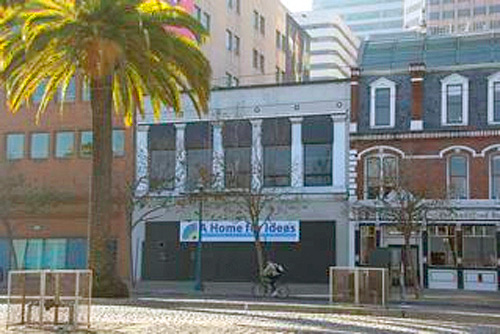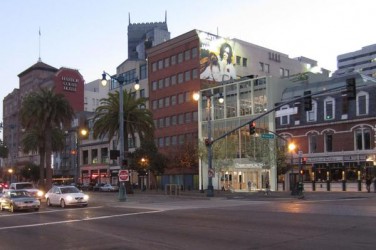SFT Deplores the Proposed Destruction of the Historic Façade of 110 Embarcadero

The Commonwealth Club is proposing to renovate 110 the Embarcadero for its headquarters. It is mystifying why this respected and normally responsible organization is considering the current unsuitable design, especially since they earlier proposed a harmonious design that would have fit well into this historic block. Instead they now propose to destroy the Embarcadero façade by installing a modern glass wall. The building would be gutted and the back side would only partially be restored. The Club is also unwilling to keep even one of the four healthy trees on the Steuart Street side.
This appeal of the negative declaration was filed by David Osgood of the Rincon Neighbors and will be heard at the Board of Supervisors on January 27, 2015. You are encouraged to attend to express your views. SFT agrees with the appellants that the City’s environmental document fails to adequately assess the impacts of the proposed partial demolition of the building on itself and on the whole block.
110 The Embarcadero is not just historic because it is 100 years old. Here was Harry Bridges’ headquarters during the 1934 waterfront strike. According to Osgood, on the infamous “Bloody Thursday” the police fired tear gas through the windows on both sides of the building. The funeral of two murdered longshoremen took place in this building, where their bodies lay in state for four days.
The Commonwealth Club has hired lawyers to help them circumvent the City’s historic preservation requirements. The Planning Commission voted to destroy the entire building in 2009, and has rubberstamped the current plan, which is why Osgood and his neighbors filed their appeal.

A rendering of the proposed facade
The Commonwealth Club originally wanted to keep a dignified facade on the Embarcadero. For reasons never explained, the Planning Department told them to go modern, says Osgood. For years, the department required developers to fit in with the context of an historic block and now they support the modern design which “clashes horribly with the beautiful Audiffred Building next door,” he says.
“It’s not just this one building,” says Osgood. The block is the last remaining block of mostly 100-year-old buildings facing the water. They have many of the original details. This is what the City side of the Embarcadero used to look like from China Basin to Fisherman’s Wharf and it will largely be transformed, agreed Heritage’s executive director Mike Buhler. Even the two newer buildings on the block have a more appropriate look than what is being proposed at 110.
Many developers and architects have gone to great lengths to restore and design appropriate new facades when they face such an historic context. The developer of the CNET building on Second Street, for example, spent an additional four million dollars just to use real brick, according to John King, and it makes all the difference.
SFT has written a letter of support for the neighbors’ appeal of the environmental evaluation which states that there would be no major impact of this alteration.


Hi. I’m opposed to development in Los Angeles where I live. Could use some help by signing up for your email distributions and talking with people. Thank you very much.